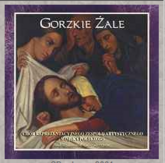 “GORZKIE ŻALE” (Bitter or Lenten Lamentations) is traditional Polish devotion during the Lent. It originates in early 18th century in the Holy Cross Church in Warsaw, Poland. Primarily it was a collection of popular songs and melodies used by people in villages around Warsaw to reflect on Passion of Christ. In 1707 Fr. Lawrence Benik CM published in print a booklet titled in Polish “Snopek Myrry z Ogroda Gethsemańskiego albo żałosne Gorzkiey Męki Syna Bożego [...] rospamiętywanie” (A bunch of Myrrh from Garden of Gethsemane or sorrowful crying over Bitter Passion of Son of God). Myrrh was one of the gifts the Three Wise Men brought to newborn Jesus as he announcement of the passion and the redemptive death of Christ. This publishing is considered as beginning of Gorzkie Zale devotion. For years this baroque multi-word phrase was used as title of the devotion. Then, with passing time, a title derived from first words of the initial song (Gorzkie Żale przybywajcie, serca nasze przenikajcie) was used more and more frequent. However the original old-Polish language is preserved until now.
“GORZKIE ŻALE” (Bitter or Lenten Lamentations) is traditional Polish devotion during the Lent. It originates in early 18th century in the Holy Cross Church in Warsaw, Poland. Primarily it was a collection of popular songs and melodies used by people in villages around Warsaw to reflect on Passion of Christ. In 1707 Fr. Lawrence Benik CM published in print a booklet titled in Polish “Snopek Myrry z Ogroda Gethsemańskiego albo żałosne Gorzkiey Męki Syna Bożego [...] rospamiętywanie” (A bunch of Myrrh from Garden of Gethsemane or sorrowful crying over Bitter Passion of Son of God). Myrrh was one of the gifts the Three Wise Men brought to newborn Jesus as he announcement of the passion and the redemptive death of Christ. This publishing is considered as beginning of Gorzkie Zale devotion. For years this baroque multi-word phrase was used as title of the devotion. Then, with passing time, a title derived from first words of the initial song (Gorzkie Żale przybywajcie, serca nasze przenikajcie) was used more and more frequent. However the original old-Polish language is preserved until now.
Fr. Bartholomew Tarlo CM, pastor of Holy Cross Parish and first Visitor of Province of Poland acknowledged importance of this devotional melodies on Passion of Christ. He ordered to rearrange the songs into structured liturgical order. The confreres used the structure of baroque Liturgy of Hours as pattern. They based the devotion on morning hour of Breviary prayers, then called Matutinum (nowadays it might be similar to Office of Readings) and Laudes prayer (present Lauds). Fr. Benik looked at old gregorian chorales to arrange music, but he kept original folklore character of melodies. Specialists can find similarities to gregorian hymnals and chorales.
Author, Fr. Lawrence Benik CM described how the devotion should be celebrated. Since the beginning it took place on Sundays of the Lent after either High Mass or Vespers. In late 18th century some liturgical elements were added making the structure very much like the present one: presentation of the Holy Sacrament at the beginning; next, three parts of the hymnals and songs were sang; following was occasional sermon called Passion Sermon. Next, there was procession with candles around the church. Finally the celebrant blessed worshippers with the Holy Sacrament.
The devotion of Gorzkie Zale spread around territory of Kingdom of Poland and Lithuania very fast. Wherever Vincentian missioners went and preached recollections and popular missions they brought Gorzkie Zale with them and planted the devotion in all these places. Soon, Gorzkie Zale became the central and most traditional Lenten celebration in Polish churches.
During three centuries of its history some changes in the melody line were introduced. There were also some attempts to translate the text into other languages, e.g. English. But after 300 years Gorzkie Zale remained typical, traditional Polish Lenten devotion piously celebrated in Poland and in most Polish communities abroad. In 2007 there were numerous events in Vincentian locations in Poland, especially in Holy Cross Church in Warsaw, commemorating 300 years of this Lenten devotion.
Modern Gorzkie Zale is not as rich in structure as the original version. It starts with Presentation of the Holy Sacrament. Wake-up (Pobudka) song follows. Next, one part (three melodies like psalms in the Lauds) is performed (the same part in every third Sunday of Lent). Passion sermon is preached next. The celebration is concludes with the blessing with Holy Sacrament. In some parishes, all three parts of Gorzkie Zale are sang as one celebration on Good Friday.
ENCYKLOPEDIA WINCENTYŃSKA contains complete text of Gorzkie Zale in Polish: PART ONE, PART TWO, PART THREE. We are preparing English text for you to let you know the devotion better if you are not speaking Polish. A choir performance will be available very soon here.
~~~~~~~~~~~~~~~~~~~~~~~~~~~~~~
Na temat historii i struktury nabożeństwa Gorzkich Żalów po polsku zachęcamy do odwiedzenia ENCYKLOPEDII WINCENTYŃSKIEJ. Tam także znajdziecie tekst wszystkich części nabożeństwa. W przygotowaniu jest przykładowe chóralne wykonanie mabożeństwa.
[...] Author, Fr. Lawrence Benik CM described how the devotion should be … Read the rest here: Nabożeństwo GORZKIE ŻALE ~ BITTER LAMENTATIONS devotion … Share [...]
Interesting article. Were did you got all the information from…
I don’t usually reply to posts but I will in this case. WoW
The original text comes from ENCYKLOPEDIA WINCENTYŃSKA and other Polish resources